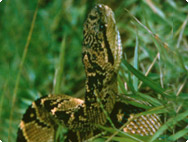A.Vogel search
When the internal search is activated, personal data such as your IP address is transmitted to our search engine Cludo. Data is thus transferred to a third country. Please click here if you want to display the internal search. You can find more information on data protection here: Privacy policy.
Lachesis muta
Bushmaster
History

Mankind has always feared yet been fascinated by snakes. They have played a major role in religion, art, legend and fairy tales, as well as in the mystical and medicinal rites of many peoples. In the Bible, we read of the serpent in Paradise, and in world history, one of the spectacled cobras, the uraeus, was worshipped by the Egyptians. The God of Healing, Aesclepius, initially took the form of a snake and carried the snake-entwined staff of Aesculapius as an emblem. This staff remains the symbol of the medical profession today. His daughter, Hygieia, the Goddess of Health, is depicted by a snake emptying its venom into a bowl. Snakes are regarded as symbols of slenderness, gentleness and wisdom, but also of dishonesty, seduction and sin. The word snake is often used to indicate treachery and maliciousness. The head of Medusa, one of the three Gorgons, is covered in snakes. Many snakes have been used in medicines since time immemorial. Antiochus III, King of Pergamum (242-187 BC), Mithridates VI Eupator, King of Pontus (132-63 BC), and Queen Cleopatra (69-30 BC) all showed an interest in poisonous snakes, trying to discover a universal antidote to protect themselves against assassination attempts. Mithridates' famous theriac (antidote), the Antidotum Mithridaticum, became famous and was used to counter poisonings from snakes, spiders and scorpions until the late Middle Ages.The homoeopathic physician Dr Constantin Hering (1800-1880), the founder of the North American Academy for Homoeopathic Medicine, added various snake venoms to the store of medications. During his stay in Surinam (1827-1833), he took the poison of the bushmaster, a snake greatly feared by the natives, and tested it in potentised form on himself and other experimental subjects. Later he tested other snake venoms and published his results.The names of the Moirae or Fates, the three daughters of Zeus and Themis – Clotho, Lachesis (who cut the thread of life), and Atropos – were all used to name species of snakes. Muta is derived from the Latin mutus for dumb or silent. Linné originally gave the bushmaster the name Crotalus mutus, which means ’dumb rattlesnake‘. The bushmaster bears various names among the natives of the Central and South American states. Among the Amazonas Indians, it is called surucúcú, in Bolivia, verrucosa or cacabela muda, in Colombia and Ecuador. rieca, on Trinidad, magepire or zarama, in Panama, mapana and in Venezuela, guaima or daya.
Zoological Characteristics
The bushmaster is the most dangerous and, with a length of 170cm to 270cm and in exceptional cases up to 400cm, the largest poisonous snake in the Americas. The flat, broad head stands out distinctly from the neck. The eye is conspicuously small with a round pupil. The bushmaster's particularly long fangs develop as tubular teeth on movable sockets. When the jaws snap shut, the contraction squeezes the secretory glands which are situated below the eyes emptying their contents into the ducts and tubes of the two poison fangs as if by syringe, into the bite wound. Interestingly, a snake's venom is not poisonous to another of the same species, but can be lethal to one of another species. Furthermore, every snake can regulate the amount of poison used. In its outward appearance, the bushmaster resembles a rattlesnake. The very knobby scales are keel-shaped and enclose the middle of the snake's body in 35 to 37 rows. The bushmaster's tail has no rattles, but it has a horny thorn behind a protruding shield, which is used to produce a whistling tone when the animal is excited.The light yellow-brown to reddish upper side of the body is covered with glossy black, rhombic patterns. These have light yellow margins and a yellow spot in the middle. The upper side of the head has black spots. A dark temperoral band connects the eyes with the corners of the mouth. The belly gleams in one yellowish-white hue.The huge, ground-dwelling snake is nocturnal and feeds on small rodents. The females lay eggs approximately 7.5cm long and guard them until the young snakes hatch.The bushmaster requires a specific temperature and humidity level, so it is difficult to keep in captivity.
Habitat
The bushmaster is native to the jungles of Central and South America. It is very shy and is thus seldom sighted.
Preparation
Snake venom is collected by manually ’milking‘ or electrically stimulating the poison glands of snakes raised on farms. Fresh venom is centrifuged and dried in a desiccator under vacuum conditions at a temperature of 37°C, or else freeze-dried (lyophilized). The bushmaster produces more venom than any other poisonous snake between 280mg and 450mg of dried venom. The Crotalus species regenerate their poison relatively slowly, so that they can only be ’milked‘ once a month. The poison consists of shiny, usually yellowish, amorphous particles of crystalline character.A.Vogel/Bioforce uses snake poison produced in accordance with the current Homöopathisches Arzneibuch (HAB) (New Official German Homoeopathic Pharmacopoeia). Potentisation of the dilutions is carried out by shaking by hand.
A.Vogel Blog – Natural and Healthy
Inspiration for a healthy life!



